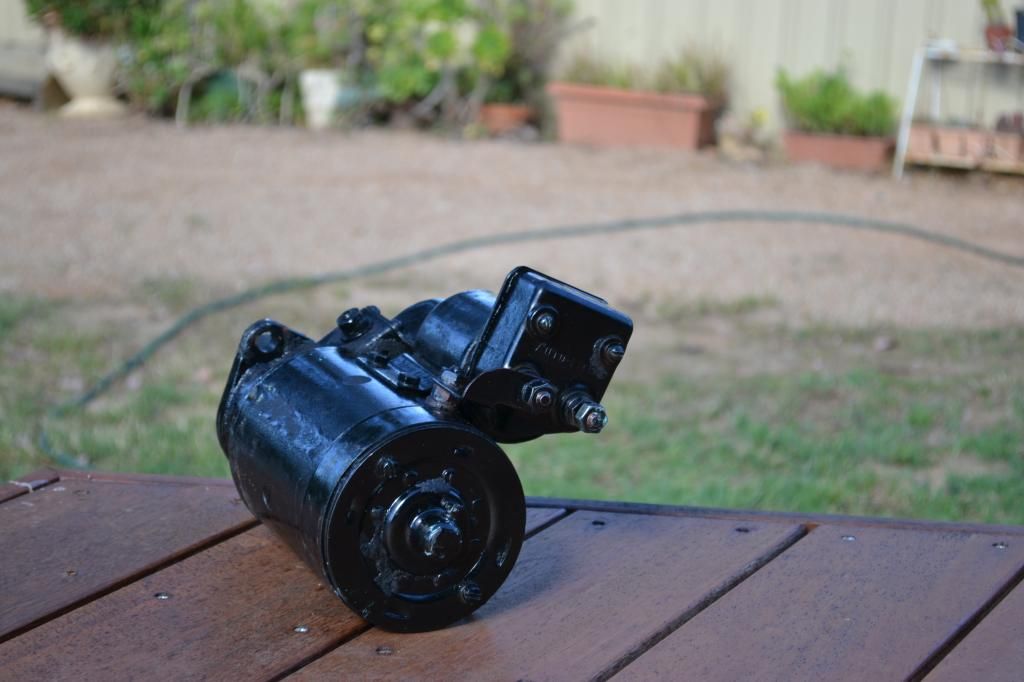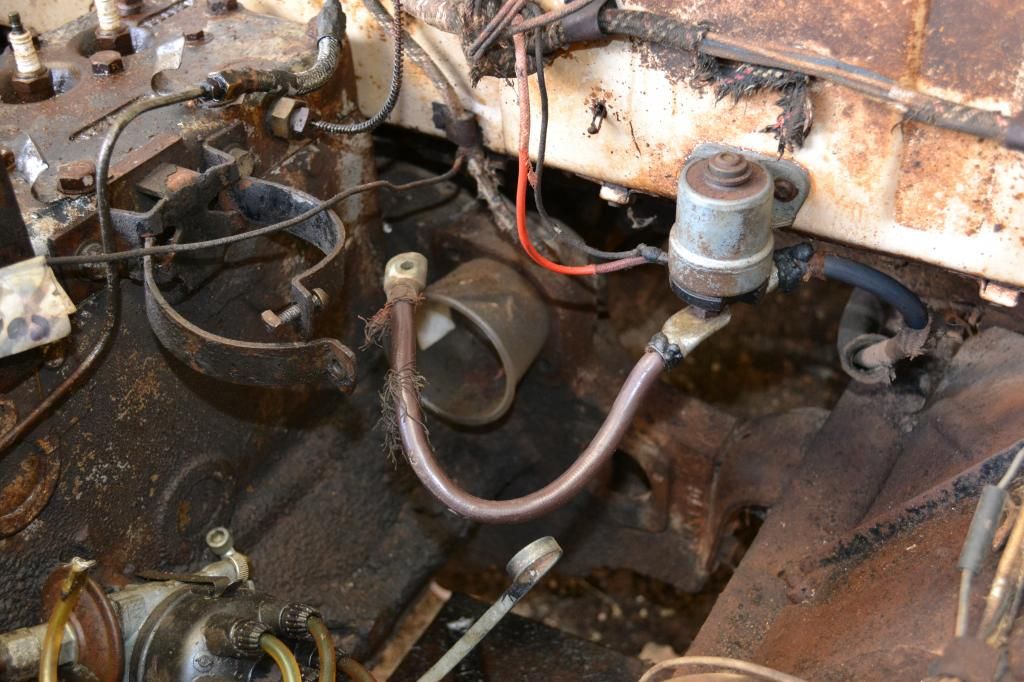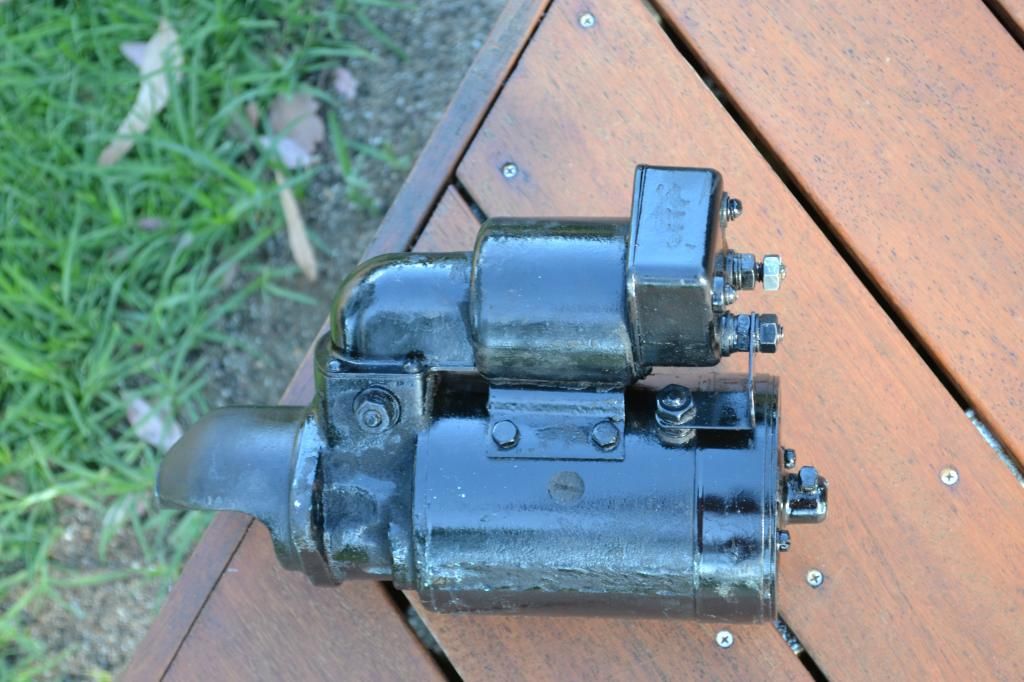- Posts: 46
- Thank you received: 8
12V starter motor for Dodge Fargo 1953
9 years 6 months ago #150228
by Geekay
12V starter motor for Dodge Fargo 1953 was created by Geekay
Anyone have a spare one for my Fargo suburban Van?
Motor is a 251 KEW.
Motor is a 251 KEW.
Please Log in to join the conversation.
9 years 6 months ago #150229
by Lang
Replied by Lang on topic Re: 12V starter motor for Dodge Fargo 1953
If you find an earlier 6v it will work just fine and give years of service. I presume you have a key/button start which are harder to find in 6v. If you have a pedal start you will be easily set 1938 onwards.
Lang
Lang
Please Log in to join the conversation.
9 years 6 months ago #150230
by Geekay
Replied by Geekay on topic Re: 12V starter motor for Dodge Fargo 1953
Thanks Lang. Yeah I have a key start, also has a starter button/solenoid in the engine bay. I have 2 6v starters, one is a foot pedal starter. I am not sure how to connect either of them. Currently the heavy lead from the solenoid has quite a small hole in the lead end and wouldn't fit onto the bolt of either of the 6 v starters. Perhaps Ijust need to change the end or drill it out.
Please Log in to join the conversation.
9 years 6 months ago - 9 years 6 months ago #150231
by Lang
Replied by Lang on topic Re: 12V starter motor for Dodge Fargo 1953
Geekay
The lead size has to do with the current flow. Both starters whether 6v or 12v have to do the same amount of work to turn the same engine.
Simply put it takes X amount of Watts to do the job.
Watts are calculated by multiplying volts (the pressure in the pipe)by amps (the flow through the pipe).
Side track - Watts are a bit out of fashion when you start talking big power like town supply so they use KVA - Kilovolt Amp ie thousand volt amps which is exactly the same as saying thousand watts. Your frypan used to be rated at 1,200 watts (240 volts X 5 amps) but it is fashionable now to say it is 1.2KVA.
So if you have 6 volts in the pipe (battery) you will need a flow of say 20 amps to get 120 watts required to do a particular job like spot lights. This requires a fat wire to allow such a high flow. The flow to a starter is much higher than this example so 6v cars have big fat wires.
If you have 12 volts in the pipe you only need 10 amps to do the same 120 watt job so the wire can be smaller.
Your 12v vehicle only needed small wires to carry the current required to operate the starter. Your 6v replacement starter came off a vehicle that had fat wires to do the same job, and obviously a bigger terminal post.
If you look at modern cars with big high compression engines you will be amazed how thin the battery cables are. They would heat up very quickly if you dropped the voltage to 6v and expected them to carry double the flow to do the same amount of work
Side track - If you look at high tension power lines they are not much thicker than your old 6 volt battery cable yet they carry 11,000 volts! This lets the power company get a huge amount of work potential (watts or KVA) at a stepped down 240 volt user voltage with very little flow (amps). If it was 240v the whole way, to get the same capacity at the end of the line the flow would require wires as thick as your leg!
If you make the hole in your 12v wire bigger to go over the 6v starter terminal you will be sweet as the same amount of work potential is still arriving at the starter.
Lang
The lead size has to do with the current flow. Both starters whether 6v or 12v have to do the same amount of work to turn the same engine.
Simply put it takes X amount of Watts to do the job.
Watts are calculated by multiplying volts (the pressure in the pipe)by amps (the flow through the pipe).
Side track - Watts are a bit out of fashion when you start talking big power like town supply so they use KVA - Kilovolt Amp ie thousand volt amps which is exactly the same as saying thousand watts. Your frypan used to be rated at 1,200 watts (240 volts X 5 amps) but it is fashionable now to say it is 1.2KVA.
So if you have 6 volts in the pipe (battery) you will need a flow of say 20 amps to get 120 watts required to do a particular job like spot lights. This requires a fat wire to allow such a high flow. The flow to a starter is much higher than this example so 6v cars have big fat wires.
If you have 12 volts in the pipe you only need 10 amps to do the same 120 watt job so the wire can be smaller.
Your 12v vehicle only needed small wires to carry the current required to operate the starter. Your 6v replacement starter came off a vehicle that had fat wires to do the same job, and obviously a bigger terminal post.
If you look at modern cars with big high compression engines you will be amazed how thin the battery cables are. They would heat up very quickly if you dropped the voltage to 6v and expected them to carry double the flow to do the same amount of work
Side track - If you look at high tension power lines they are not much thicker than your old 6 volt battery cable yet they carry 11,000 volts! This lets the power company get a huge amount of work potential (watts or KVA) at a stepped down 240 volt user voltage with very little flow (amps). If it was 240v the whole way, to get the same capacity at the end of the line the flow would require wires as thick as your leg!
If you make the hole in your 12v wire bigger to go over the 6v starter terminal you will be sweet as the same amount of work potential is still arriving at the starter.
Lang
Last edit: 9 years 6 months ago by Lang.
Please Log in to join the conversation.
9 years 6 months ago #150232
by Geekay
Replied by Geekay on topic Re: 12V starter motor for Dodge Fargo 1953
Thanks Lang.
Clearly electrics not my strong suit and I am always reluctant to just try something because it can have horrible results.
Clearly electrics not my strong suit and I am always reluctant to just try something because it can have horrible results.
Please Log in to join the conversation.
Less
More
- Posts: 25
- Thank you received: 0
9 years 5 months ago #150233
by 1939indiana
Replied by 1939indiana on topic Re: 12V starter motor for Dodge Fargo 1953
Guys.
When I converted my 6v system to 12v, the auto sparky used a 2 pak epoxy resin to impregnate the wiring in the starter motor rotor, just to ensure it will not fly to pieces under the 12v load.
Still going after 20 odd years.
Peter.
When I converted my 6v system to 12v, the auto sparky used a 2 pak epoxy resin to impregnate the wiring in the starter motor rotor, just to ensure it will not fly to pieces under the 12v load.
Still going after 20 odd years.
Peter.
Please Log in to join the conversation.
9 years 5 months ago #150234
by atkipete
Replied by atkipete on topic Re: 12V starter motor for Dodge Fargo 1953
The sparky rewound my 6 volt Dodge one and said it was fine for 12 volt. Make sure your battery cable is well insulated and cant wear thru onto the body.
Please Log in to join the conversation.
9 years 5 months ago #150235
by Geekay
Replied by Geekay on topic Re: 12V starter motor for Dodge Fargo 1953
Thanks all.
Seems like just sticking with the 6v starter is the way to go.
I have 2, one has the foot activator.
I will take both to the auto electrician today to make sure they work before I bolt it on. That inside bolt of the starter up against the engine block is a mongrel to get at and I don't feel like bolting on a starter that isn't working.
Seems like just sticking with the 6v starter is the way to go.
I have 2, one has the foot activator.
I will take both to the auto electrician today to make sure they work before I bolt it on. That inside bolt of the starter up against the engine block is a mongrel to get at and I don't feel like bolting on a starter that isn't working.
Please Log in to join the conversation.
9 years 5 months ago #150236
by Geekay
Replied by Geekay on topic Re: 12V starter motor for Dodge Fargo 1953
Starter serviced and bolted on.
I attached the brown cable from the starter button in the engine bay to the larger post on the right side of the starter solenoid. Hoping that this would work.
In the pic you will see the black cable from the battery neg terminal attached to this starter button and a red and black wire from the wire loom (I assumed from ignition key/button).
Hooked up a spare 12 v battery to the Fargo, turned on ignition key and pushed the starter button (in the cabin)
The starter motor made a loud click but bendix drive did not fully react and engage gear/turn motor.
I am hoping this was just because the battery did not have enough charge, which is possible. Put it on the charger today.
Also hoping that this 6v starter motor bendix drive will turn in the gear in the right direction .
Any hints/advice please reply.
I attached the brown cable from the starter button in the engine bay to the larger post on the right side of the starter solenoid. Hoping that this would work.
In the pic you will see the black cable from the battery neg terminal attached to this starter button and a red and black wire from the wire loom (I assumed from ignition key/button).
Hooked up a spare 12 v battery to the Fargo, turned on ignition key and pushed the starter button (in the cabin)
The starter motor made a loud click but bendix drive did not fully react and engage gear/turn motor.
I am hoping this was just because the battery did not have enough charge, which is possible. Put it on the charger today.
Also hoping that this 6v starter motor bendix drive will turn in the gear in the right direction .
Any hints/advice please reply.
Please Log in to join the conversation.
9 years 5 months ago - 9 years 5 months ago #150237
by Lang
Replied by Lang on topic Re: 12V starter motor for Dodge Fargo 1953
Starters always turn in the same direction (that they are built to run), regardless of polarity.
Just reading your post it sounds to me like you are trying to run your start power through the starter switch.
The big terminal on the starter should have the big + cable straight from the battery hooked up.
The box containing the solenoid, which is just a large electric contact switch, normally should have a small screw or spade terminal. This should have a small + wire going to it from the ignition switch or starter button.
You look like you have a stand alone solenoid and the small + wire should go to the small terminal on this. This small wire creates a current in a coil which in turn creates a magnetic field. In the centre of the coil is a spring loaded "bolt". When the electric current operates, the magnetic field pulls the bolt into contact across the big terminals so you have high current flow. In pommy cars of the 50/60 era the "bolt" stuck out the top of the solenoid with a rubber cover so you could manually push it in to get contact - very handy if you are working under the bonnet by yourself doing say, a compression check.
These stand alone solenoids do give trouble. You can test by just running a jump lead from the battery direct to the starter terminal. When you touch the lead on to test do it firmly to make good contact to get the starter spinning and avoid sparks.
The solenoid system gave the convenience of a push-button starter and saved the effort of pushing a floor pedal (your foot just closed the circuit across the two big wires instead of the solenoid "bolt"). The first part of your foot travel pushed the starter gear into the flywheel before electrical contact.
The next development was the Bendix gear which threw the starter into the flywheel when contact was made. That allowed an electric floor switch like a headlight dip switch which carried the entire starter current.
The solenoid system allowed small currents to be floating around behind the dash for the convenience of a key or button start. With a foot start people had problems on hills, particularly on a cold morning with one foot on the brake (handbrakes are often poor), one foot pressing the starter and the third foot trying to operate the accelerator..
Lang
Just reading your post it sounds to me like you are trying to run your start power through the starter switch.
The big terminal on the starter should have the big + cable straight from the battery hooked up.
The box containing the solenoid, which is just a large electric contact switch, normally should have a small screw or spade terminal. This should have a small + wire going to it from the ignition switch or starter button.
You look like you have a stand alone solenoid and the small + wire should go to the small terminal on this. This small wire creates a current in a coil which in turn creates a magnetic field. In the centre of the coil is a spring loaded "bolt". When the electric current operates, the magnetic field pulls the bolt into contact across the big terminals so you have high current flow. In pommy cars of the 50/60 era the "bolt" stuck out the top of the solenoid with a rubber cover so you could manually push it in to get contact - very handy if you are working under the bonnet by yourself doing say, a compression check.
These stand alone solenoids do give trouble. You can test by just running a jump lead from the battery direct to the starter terminal. When you touch the lead on to test do it firmly to make good contact to get the starter spinning and avoid sparks.
The solenoid system gave the convenience of a push-button starter and saved the effort of pushing a floor pedal (your foot just closed the circuit across the two big wires instead of the solenoid "bolt"). The first part of your foot travel pushed the starter gear into the flywheel before electrical contact.
The next development was the Bendix gear which threw the starter into the flywheel when contact was made. That allowed an electric floor switch like a headlight dip switch which carried the entire starter current.
The solenoid system allowed small currents to be floating around behind the dash for the convenience of a key or button start. With a foot start people had problems on hills, particularly on a cold morning with one foot on the brake (handbrakes are often poor), one foot pressing the starter and the third foot trying to operate the accelerator..
Lang
Last edit: 9 years 5 months ago by Lang.
Please Log in to join the conversation.
Time to create page: 0.477 seconds


